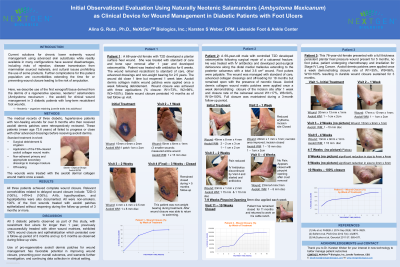Case Series/Study
(CS-125) Initial Observational Evaluation Using Naturally Neotenic 1 Salamanders (Ambystoma Mexicanum) as Clinical Device for Wound Management in Diabetic Patients with Foot Ulcers

Current solutions for foot ulcer wound management using advanced skin substitutes have several disadvantages, including risks of rejection, disease transmission from mammalian sourced materials, and cultural issues prohibiting the use of some products. Here, we describe the first use of a xenograft tissue derived from the dermis of a regenerative species, neotenic1 salamanders (Ambystoma mexicanum - the axolotl) for clinical wound management in 3 diabetic patients with long-term recalcitrant foot wounds.
Methods:
The medical records of three diabetic, hypertensive patients with non-healing wounds over 6 months who then received axolotl dermis patches were retrospectively reviewed. These patients (mean age 73.6 y) all failed to progress or close with other advanced dressings before receiving axolotl dermis.
Results:
All three patients achieved complete wound closure. Relevant comorbidities related to delayed wound closure include: T2D=3 (100%), HTN=3 (100%); A fib, hypothyroidism, and hypolipidemia were also documented. All were non-smokers. 100% of the foot wounds treated with axolotl patches epithelialized without reopening during the follow-up period of 3 months or more.
Patient 1: Recalcitrant to other advanced dressings and spur removal for 2.5 years, a 1.3 cm x 1.6 cm x 0.1cm pressure ulcer of the plantar surface of the heel was treated with axolotl dermis patches once a week demonstrating wound closure with three applications (% closure: W1=73%, W2=98%, W3=100%). Stable wound closure persisted >5 months.
Patient 2: Post-surgical dehiscence of the posterior heel and medial malleolus with a total 3.6 cm2 wound and patient receiving IV antibiotics, unsuccessfully managed for 18 months, was treated with axolotl dermis patches once a week demonstrating closure rate of W1=17%, W6=94%, W11=100%. Full closure was maintained during a 3-month follow-up period.
Patient 3: Full thickness persistent plantar heel pressure wound for 5 months was treated with axolotl dermis patches once a week demonstrating closure rate of W1=35%, W9=96%, W12=100% resulting in durable wound closure sustained for 3 months.
Discussion:
Use of pro-regenerative axolotl dermis patches for wound management has favorable potential in improving wound closure, preventing poor overall outcomes, warrants further investigation, and continuing data collection in clinical setting.
Trademarked Items:
References: 1 Neotenic - organism retaining juvenile traits into adulthood

.png)